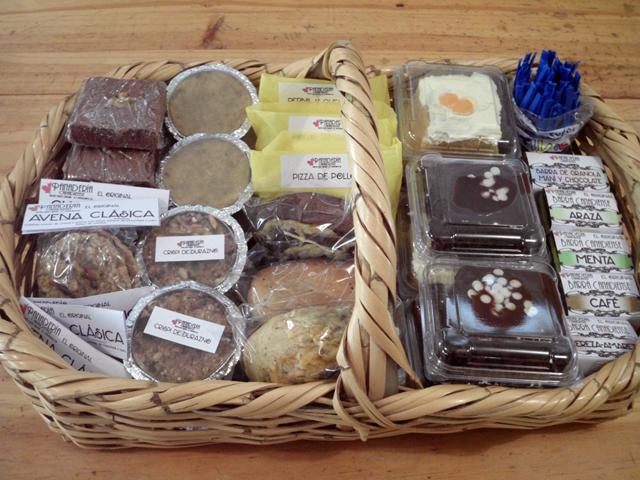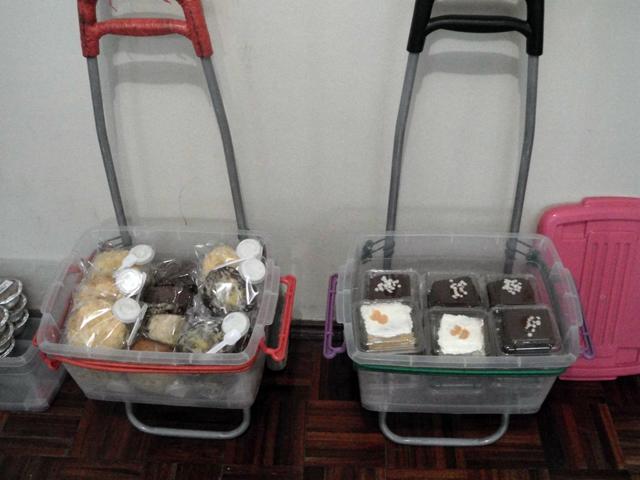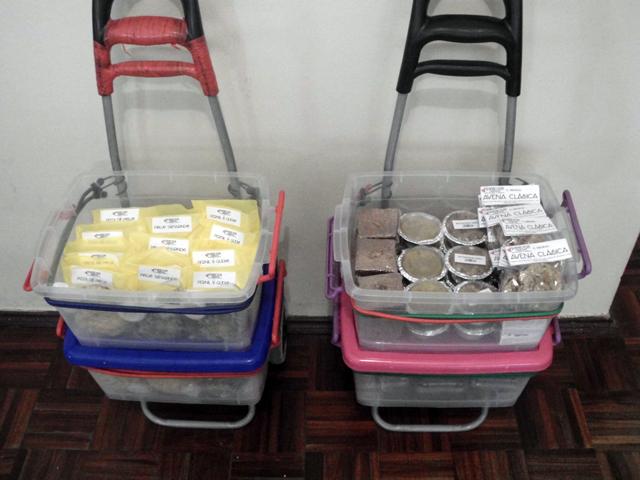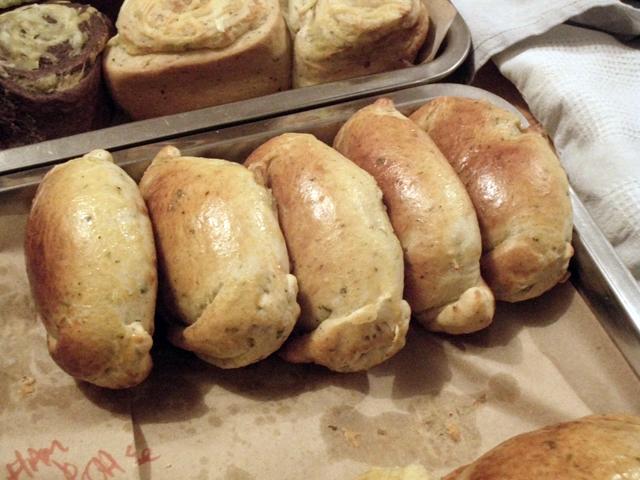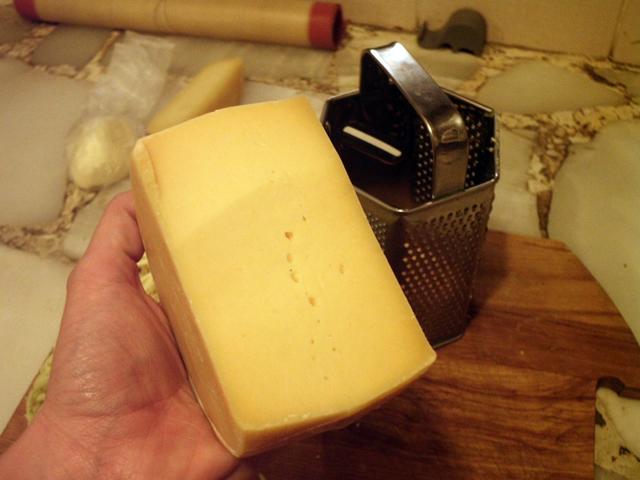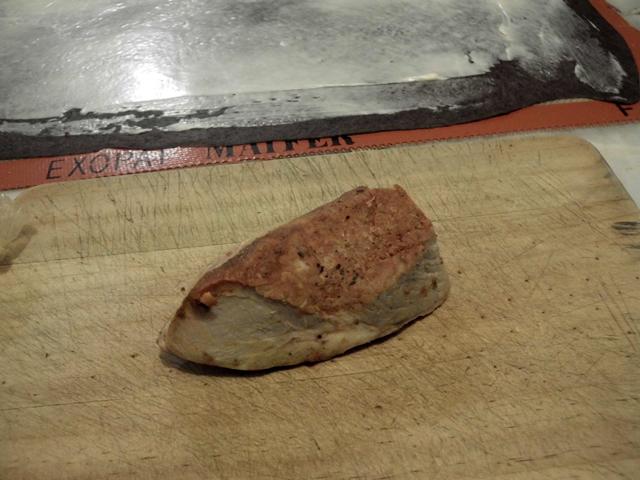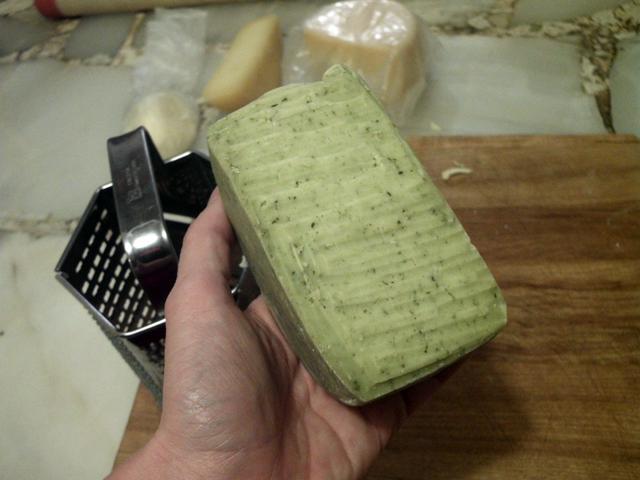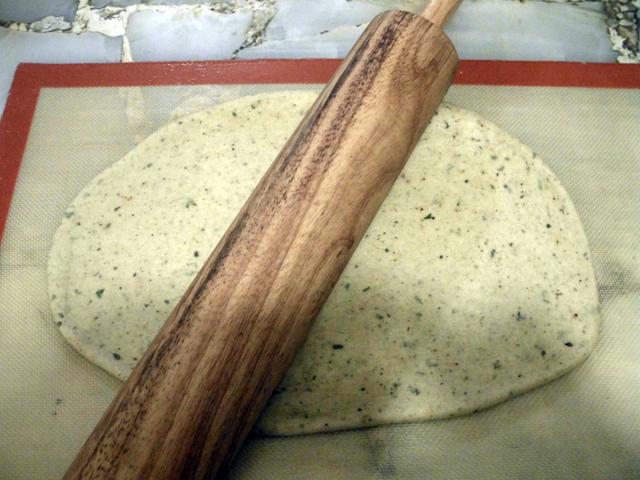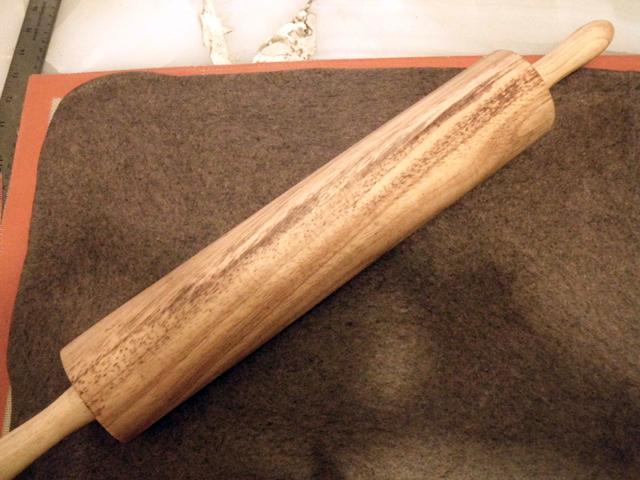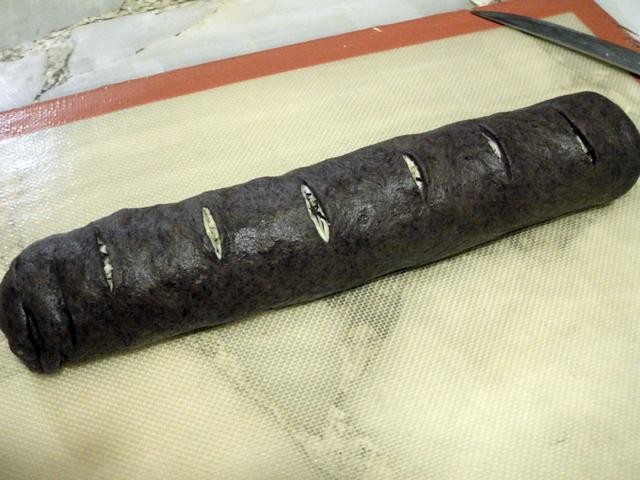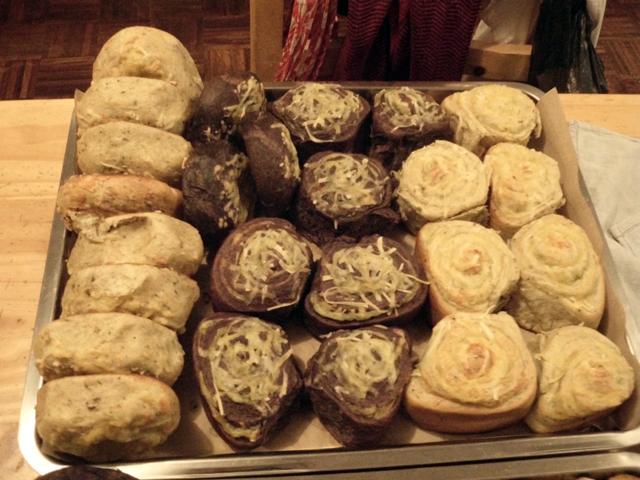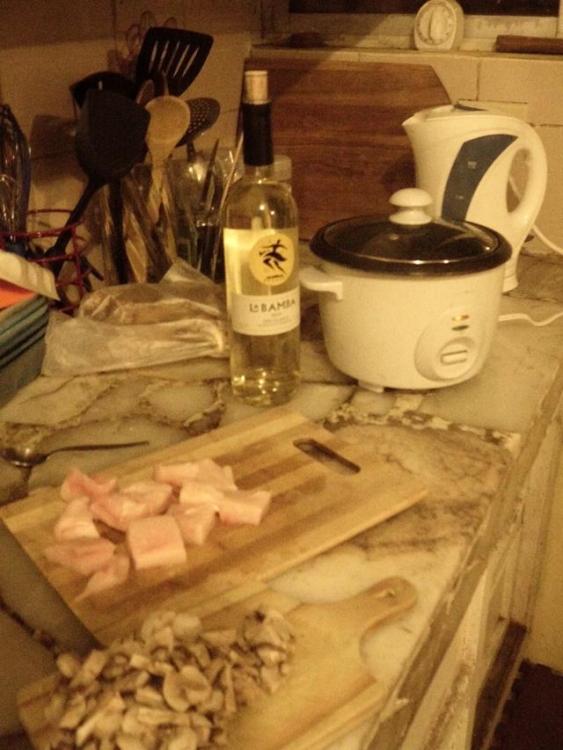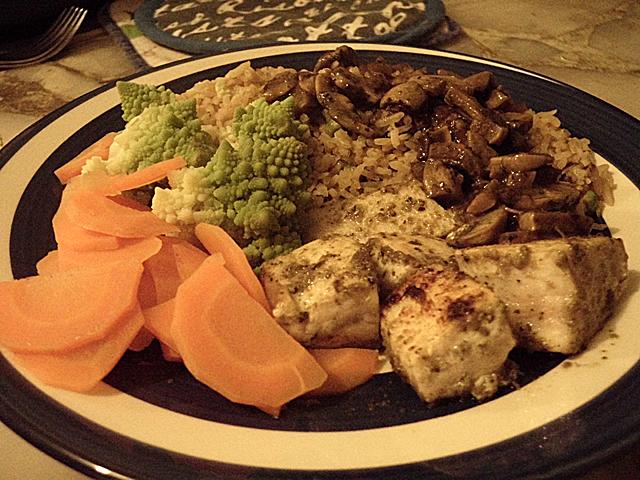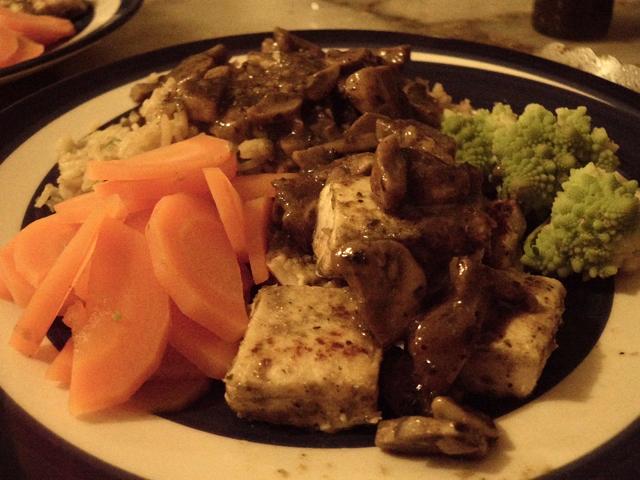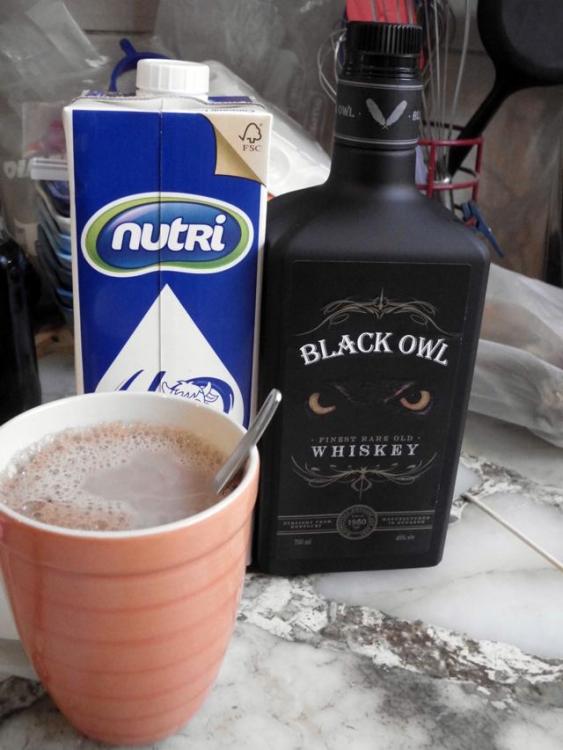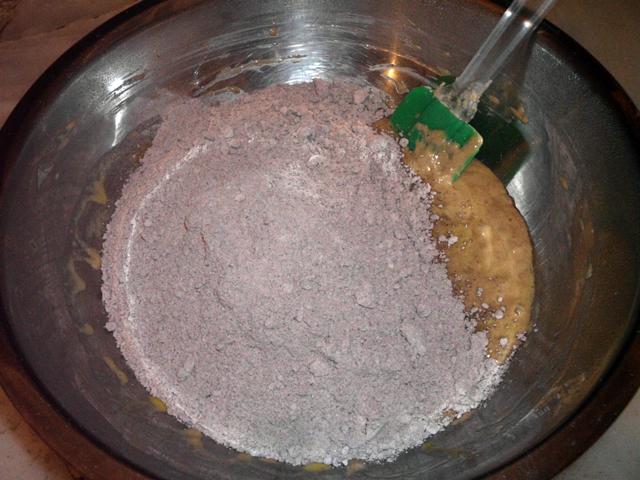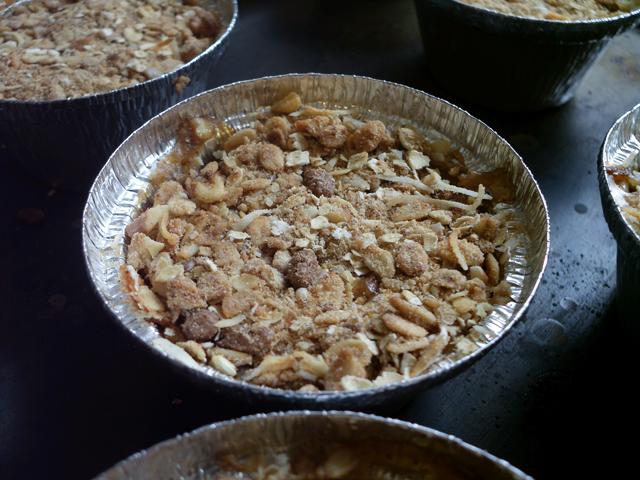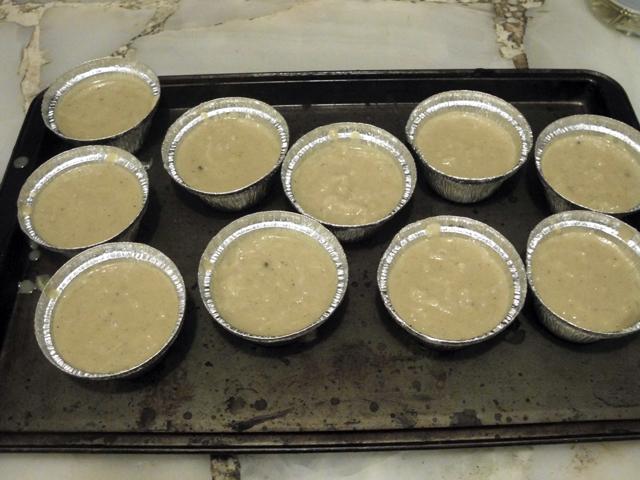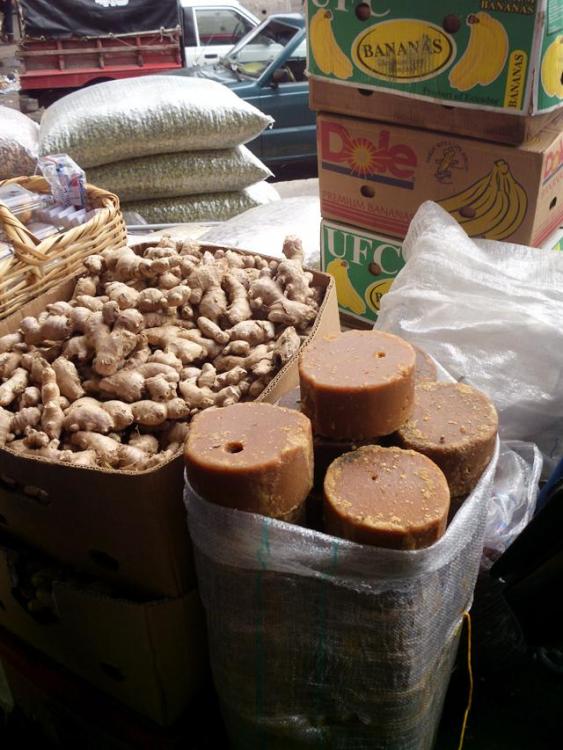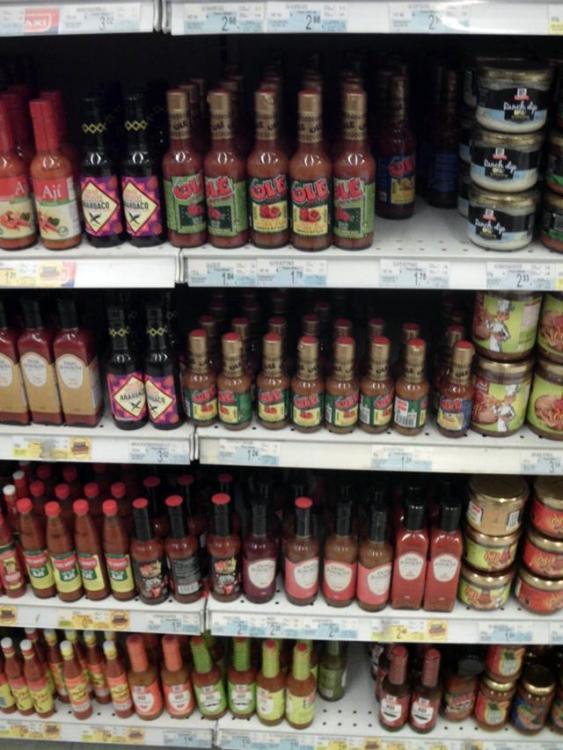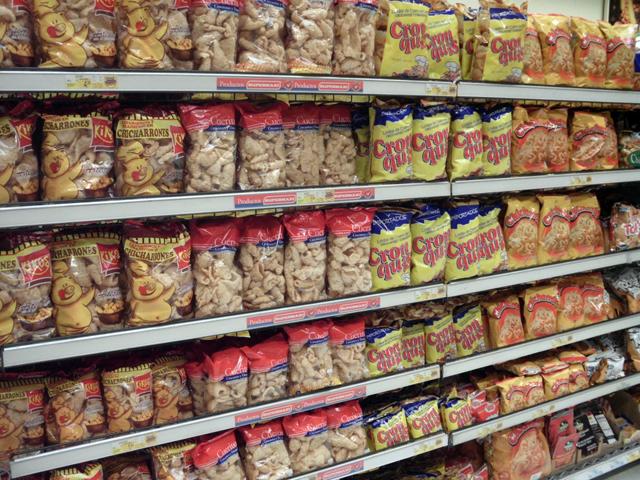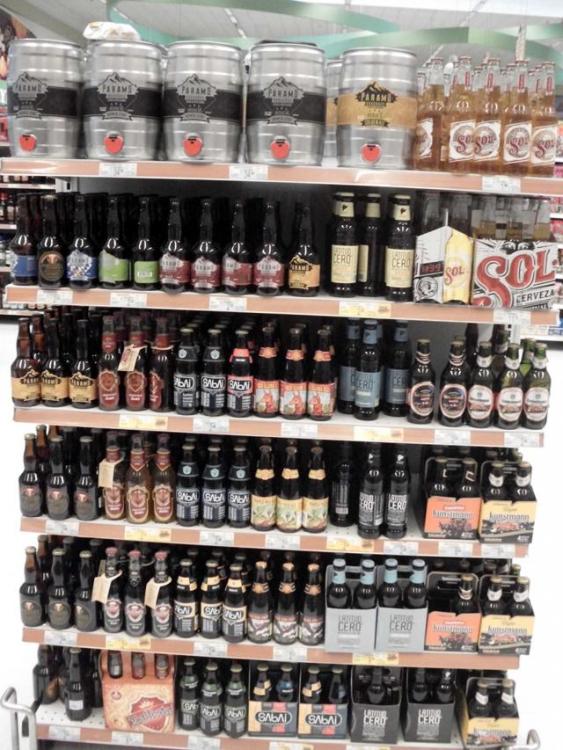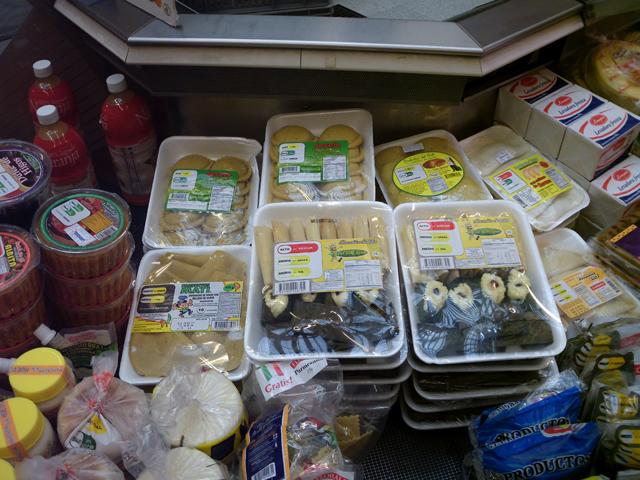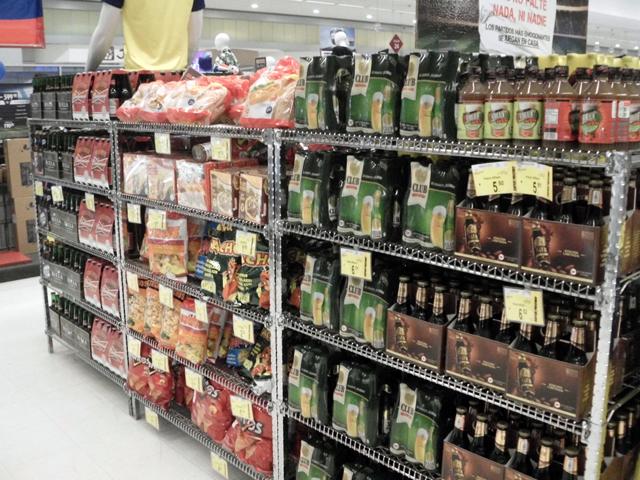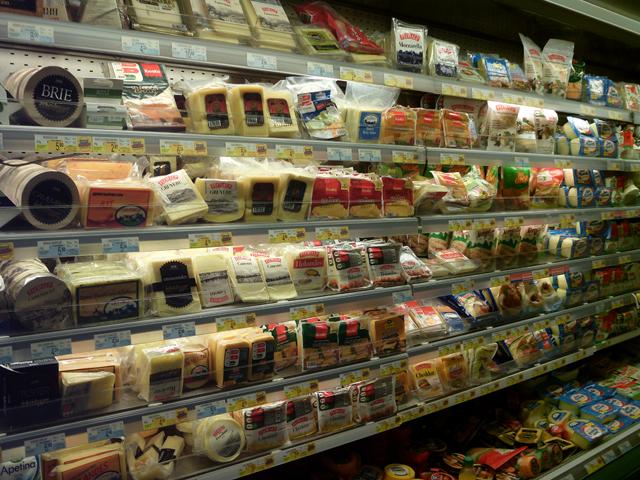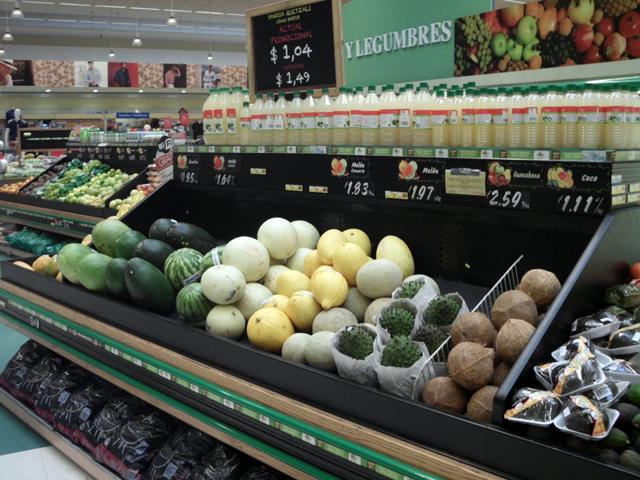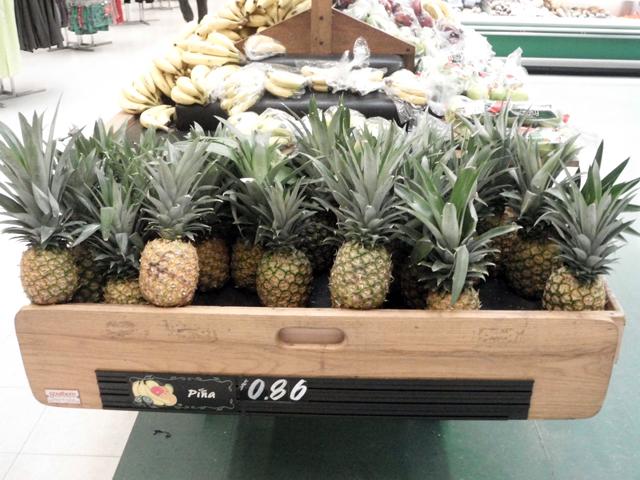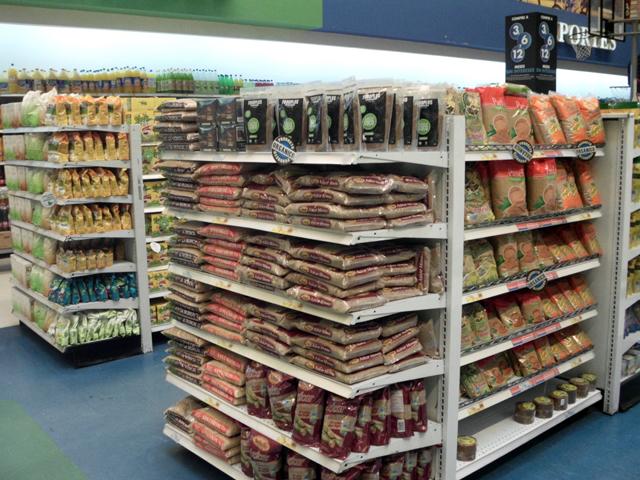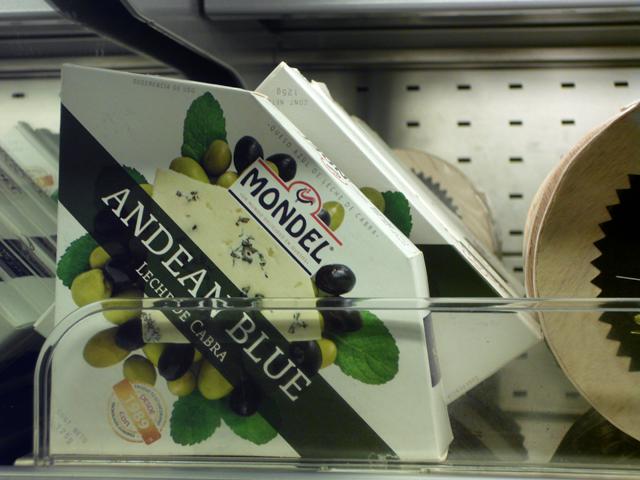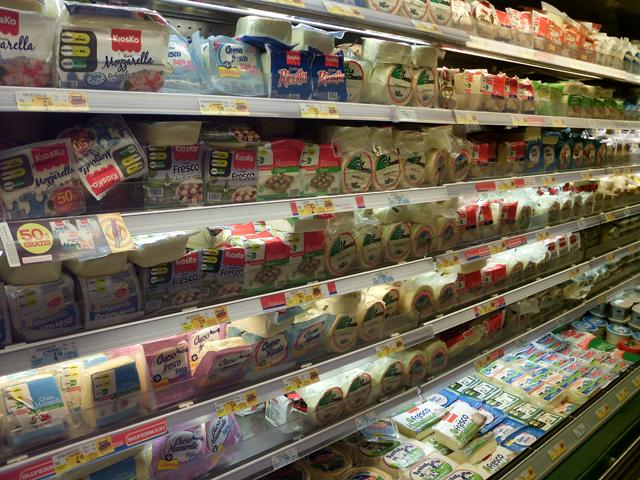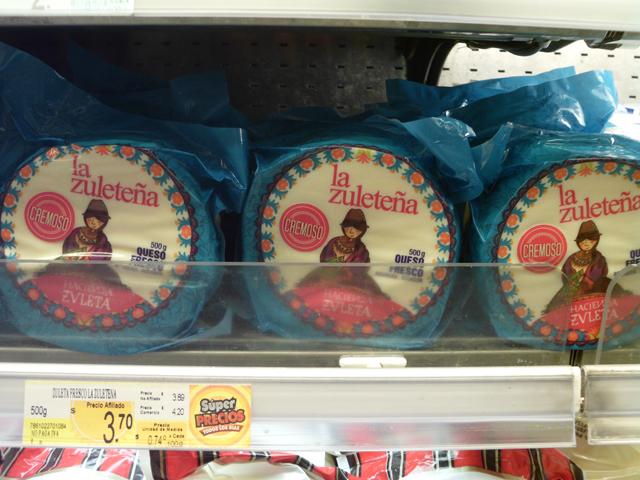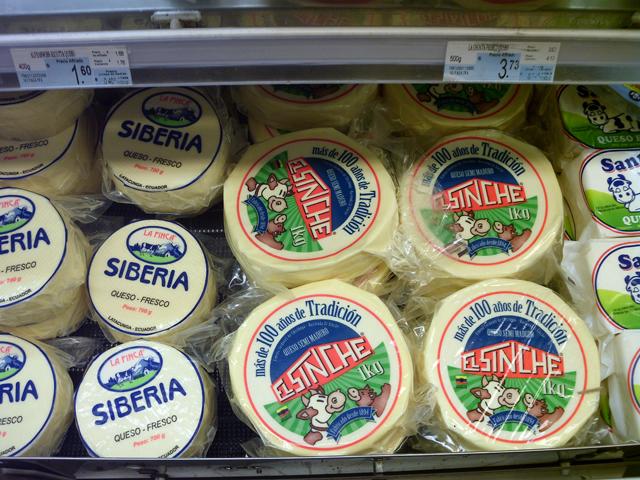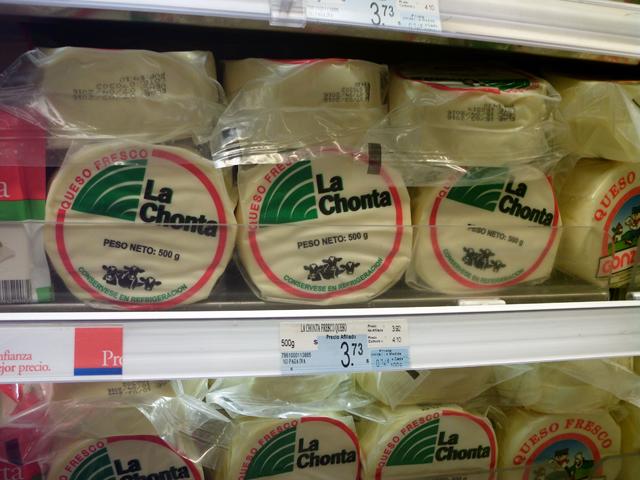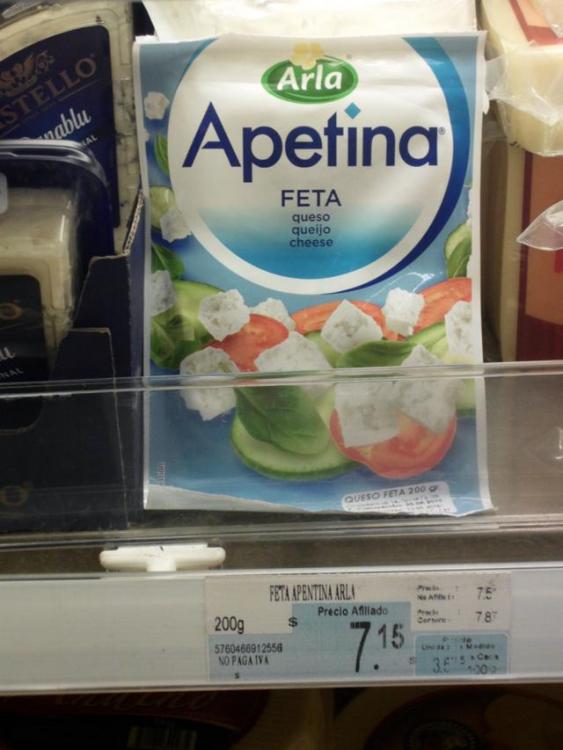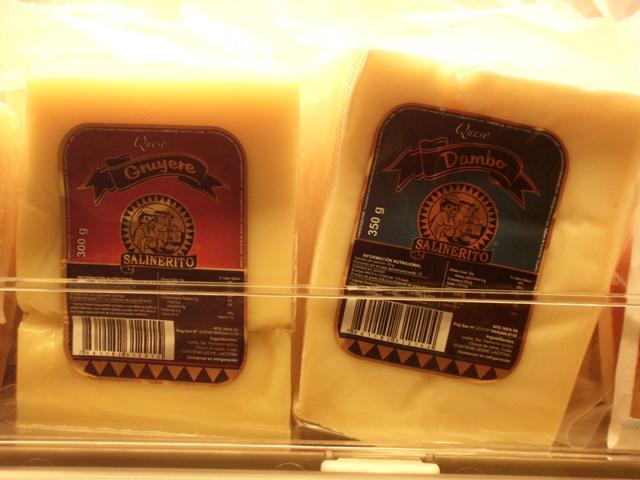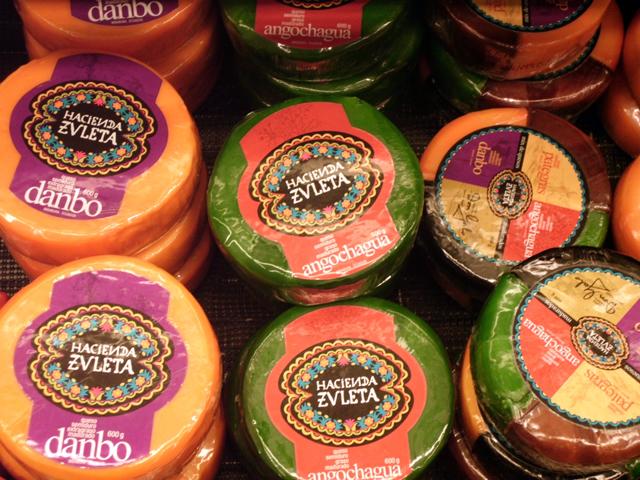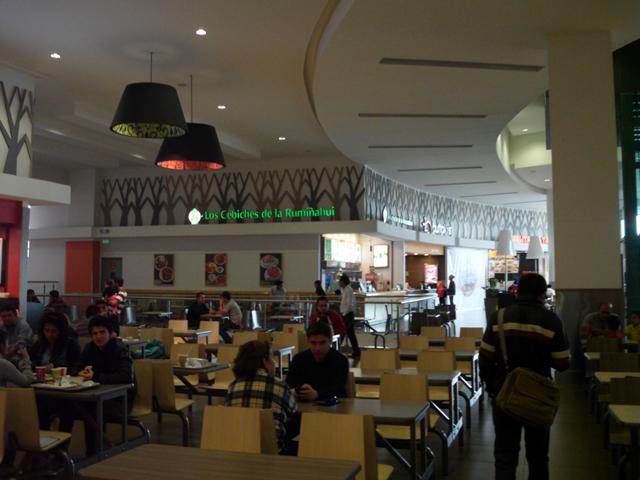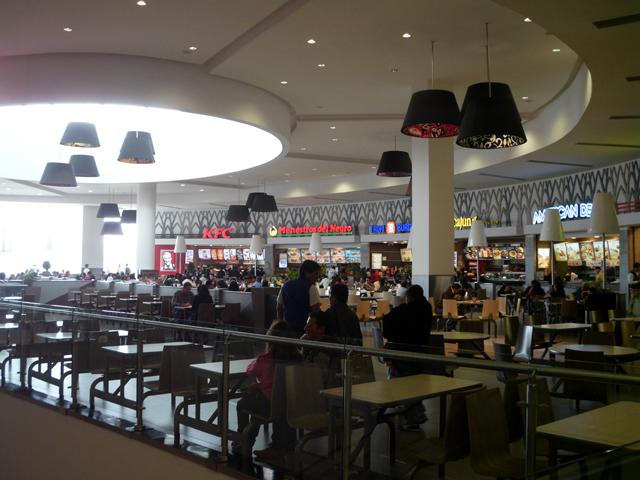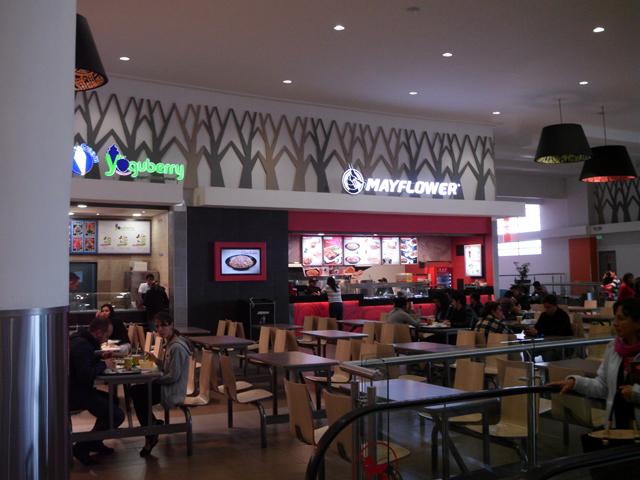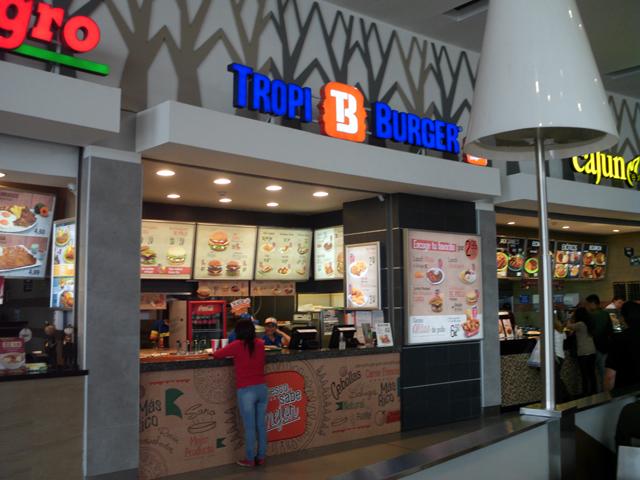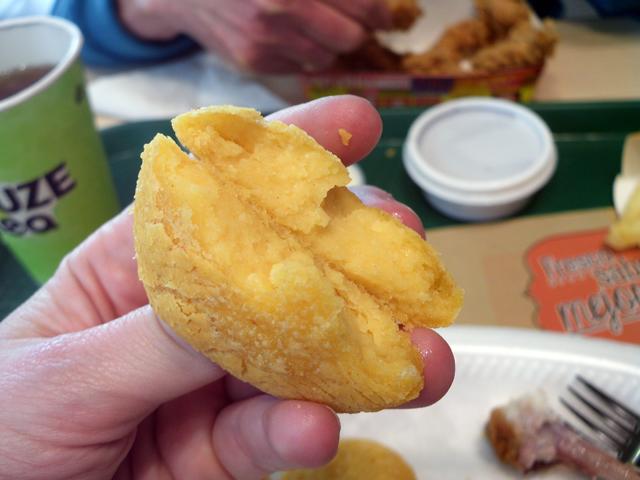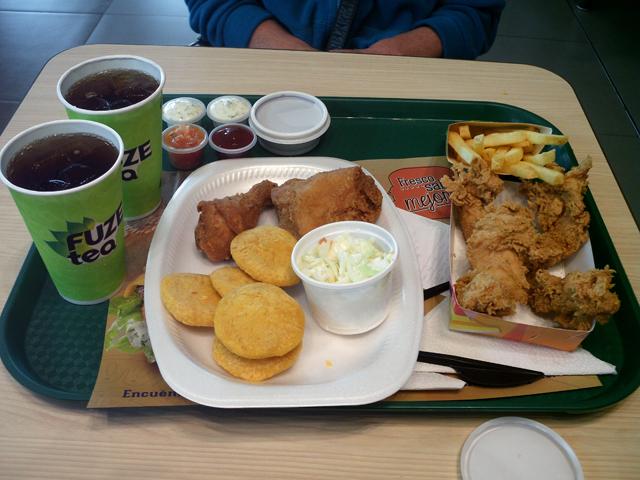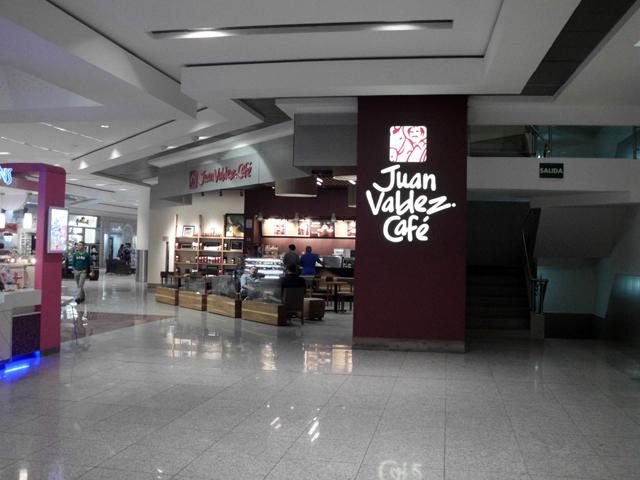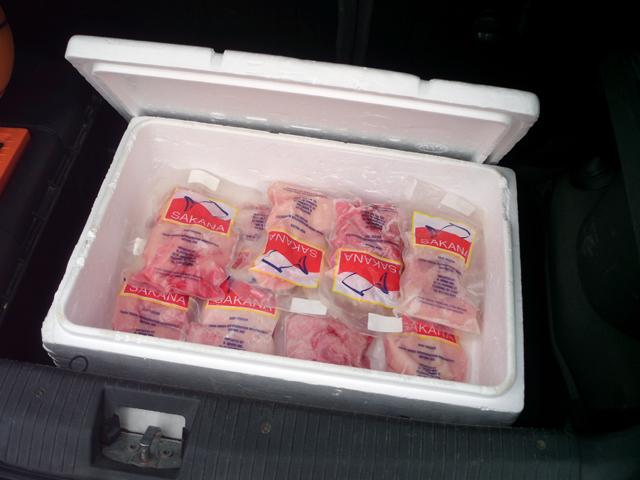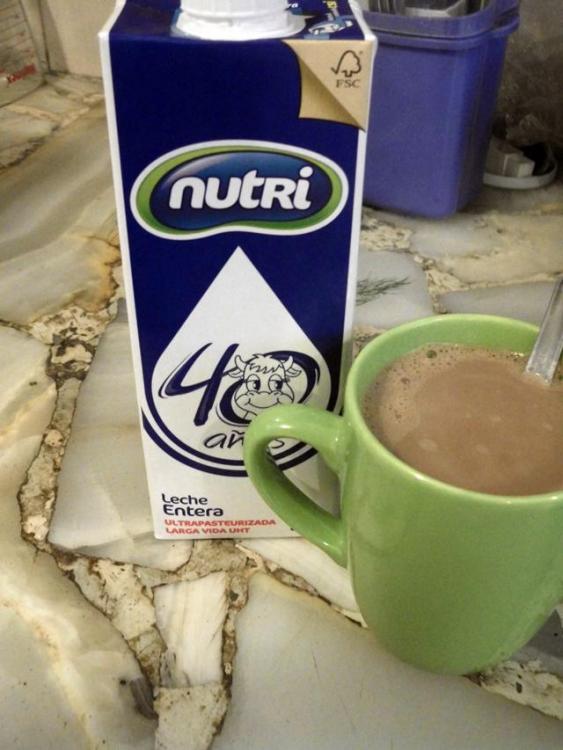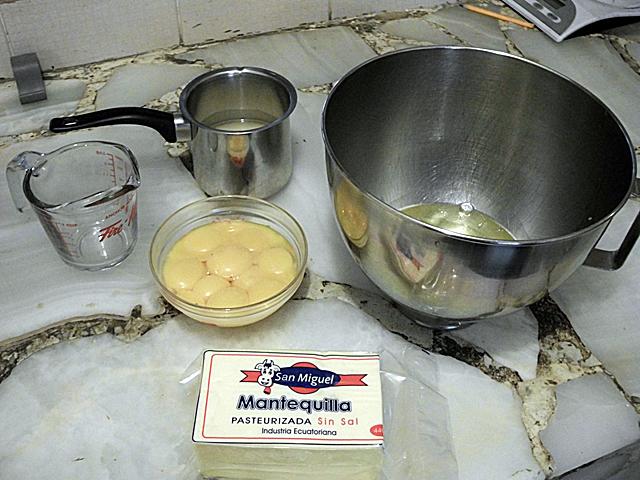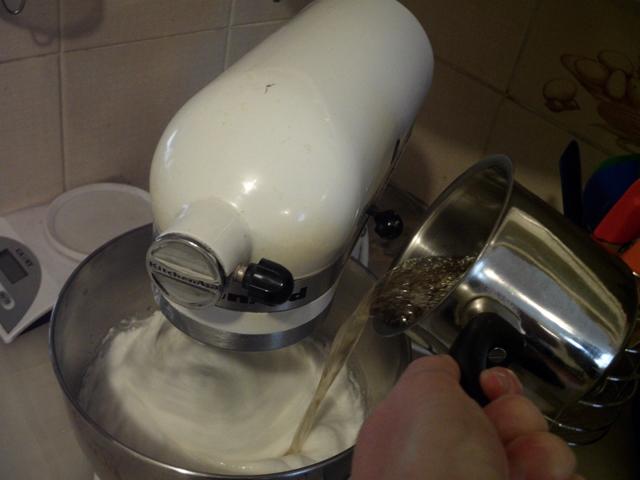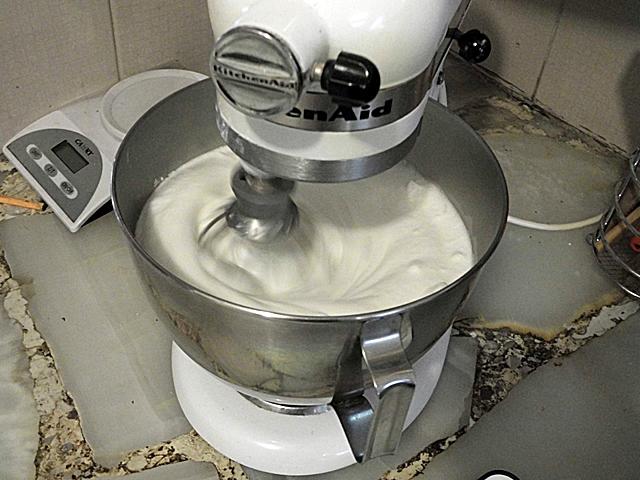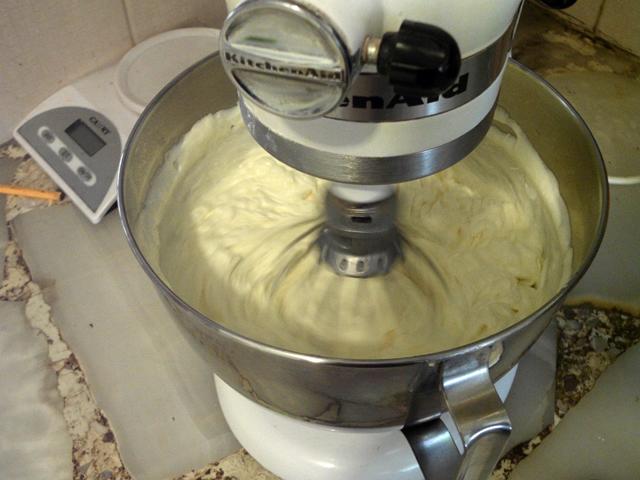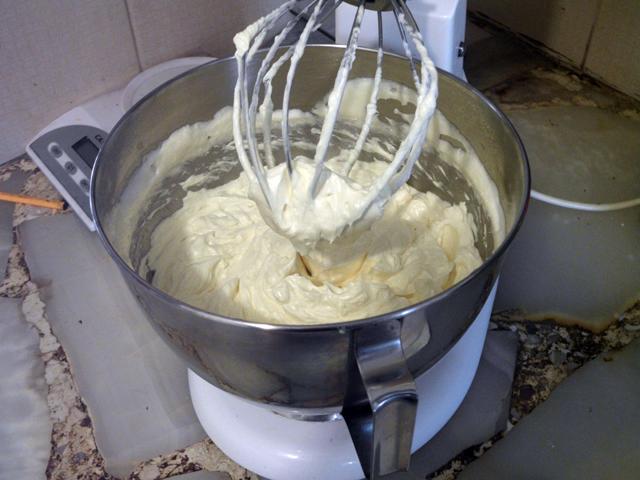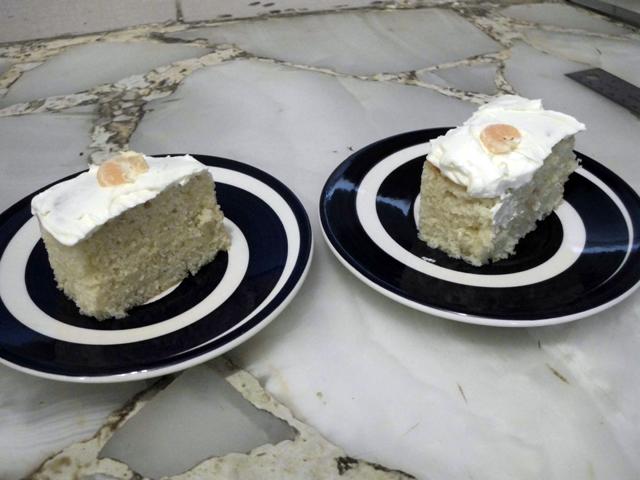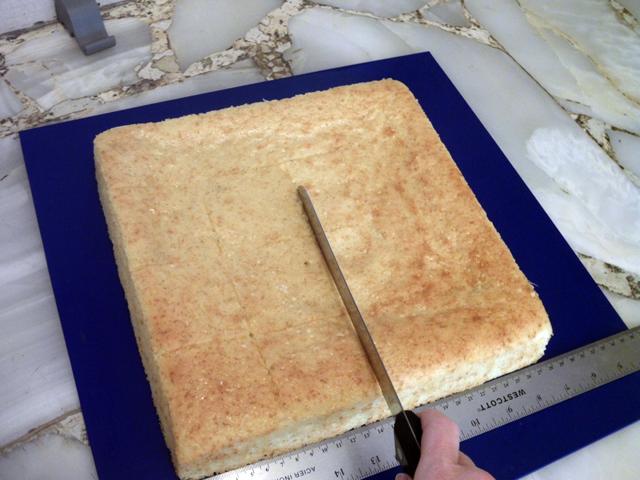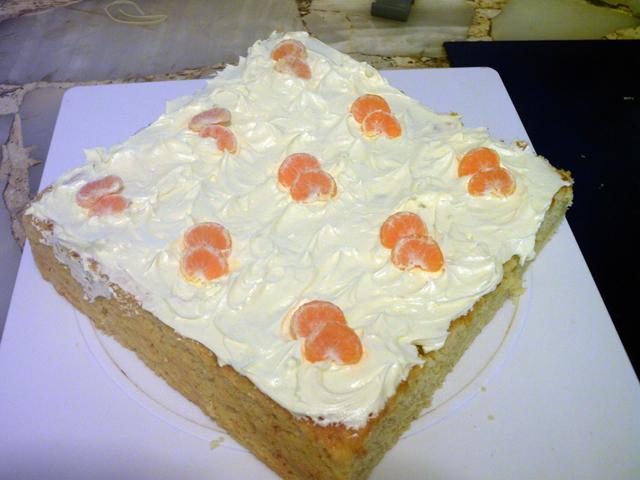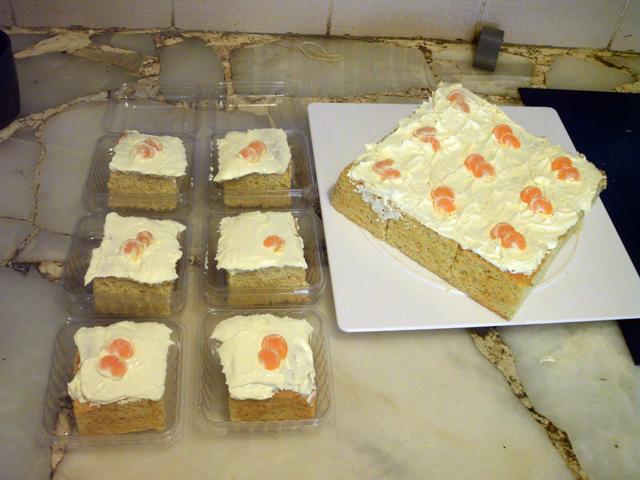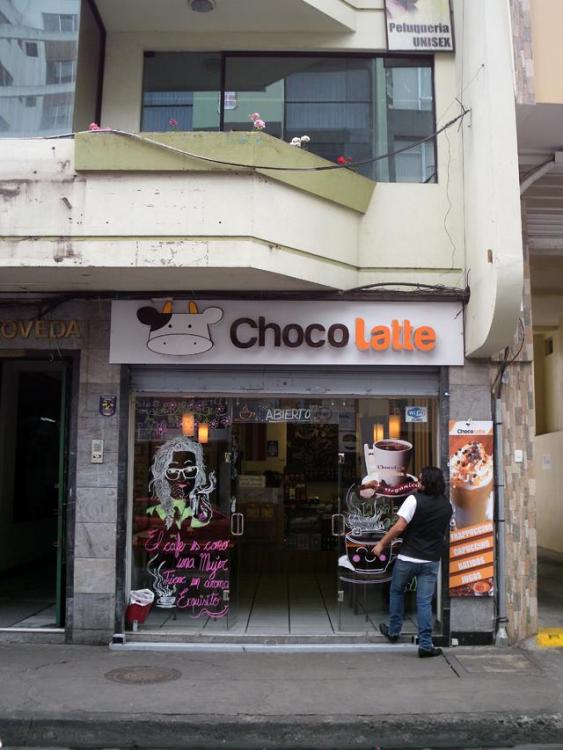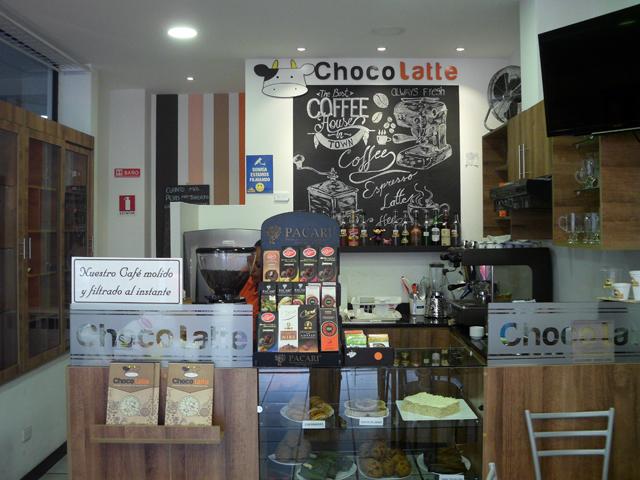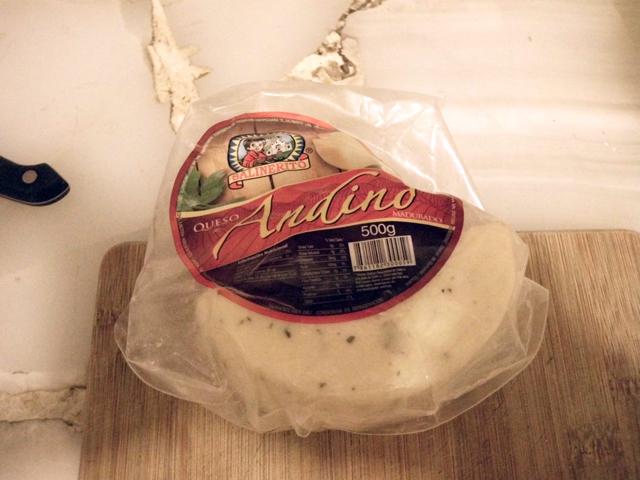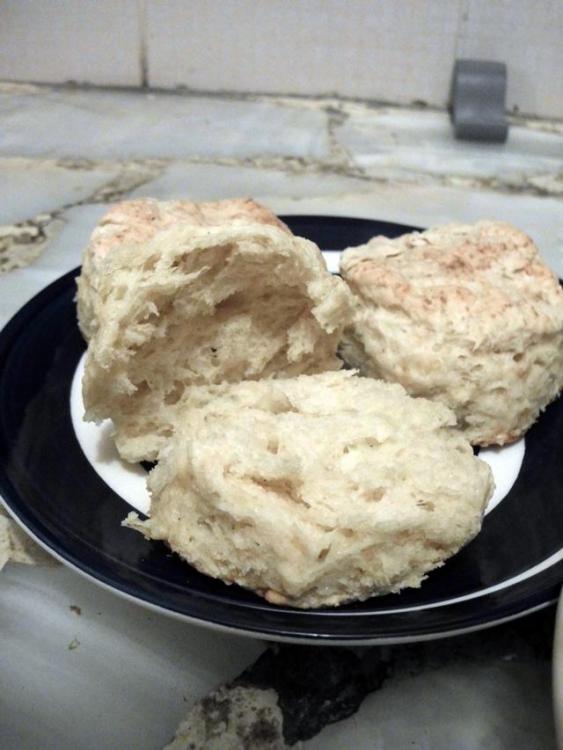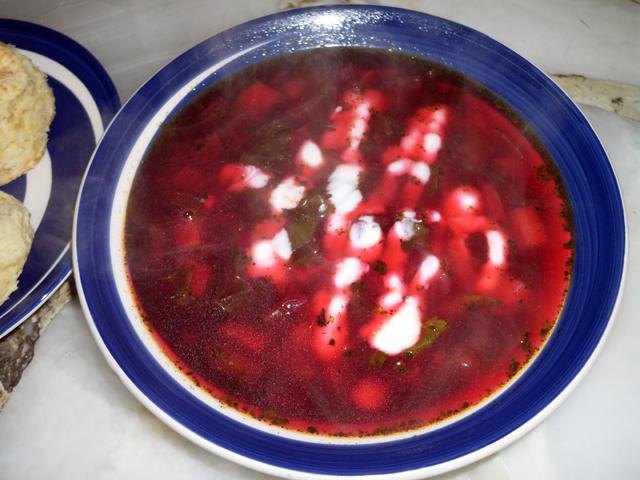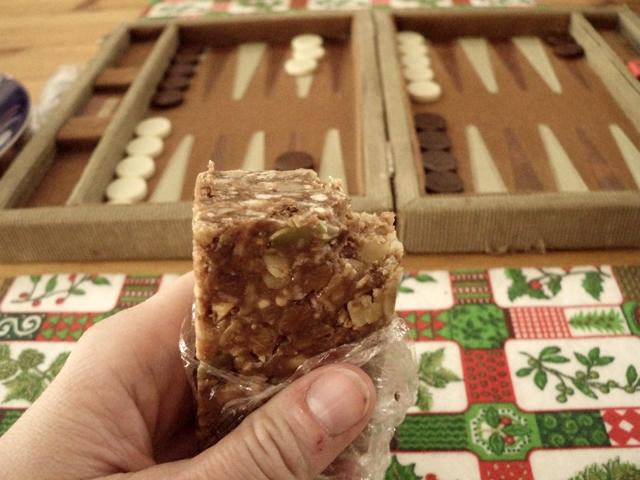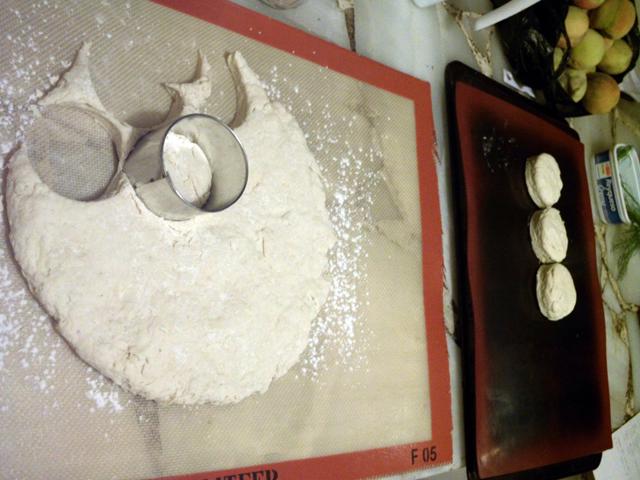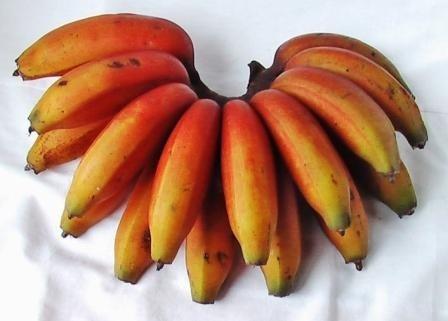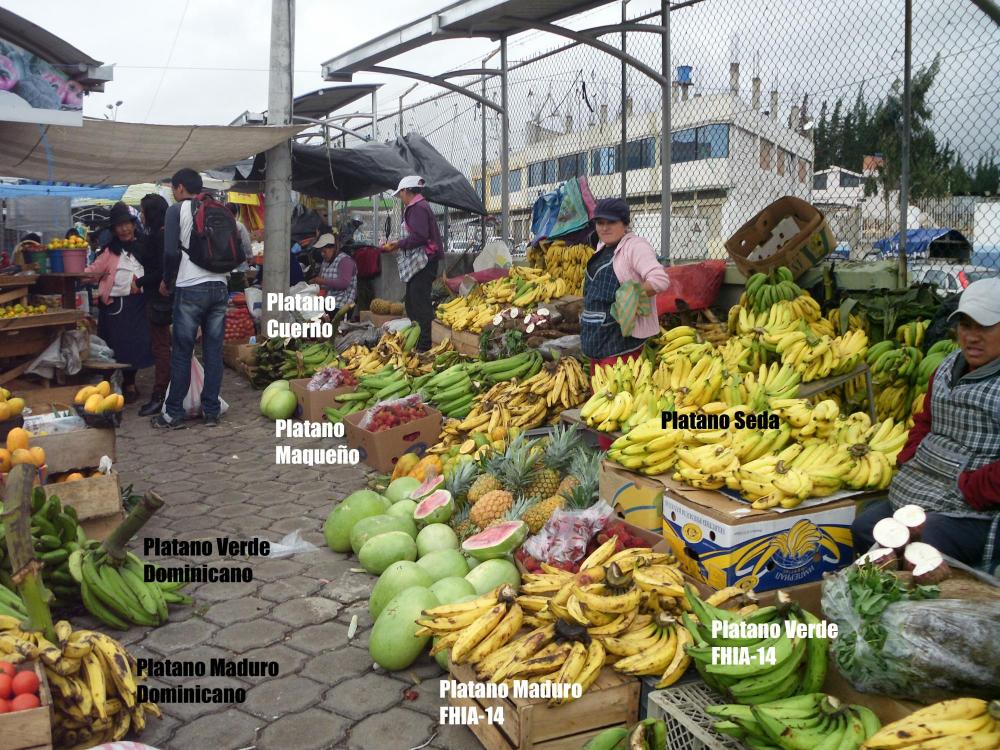-
Posts
2,383 -
Joined
-
Last visited
Content Type
Profiles
Forums
Store
Help Articles
Everything posted by Panaderia Canadiense
-
If you don't do anything other than shop, eat, and post to eGullet, you too can produce this volume of goodies and still get a solid 6 hours a night! Seriously though, Stepdad takes the night shift and is responsible for bagels and empanadas, and for baking the spirals; Mom works alongside me during the day.
-
Sadly, most commercial bakeries use a rather frightening hydrogenated margarine product in their puff pastries - it's meant to stay solid even working at the higher temperatures of an industrial kitchen. I don't suggest you go this route, but rather use butter or coconut oil (fats that remain solid at room temperature) for puff pastry. The fats need to remain solid right up until baking, because their melting is what gives puff pastry its lift and flake. Filo is a different creature entirely; for that you can use oil or melted butter. Most commercial bakeries that work with filo use the cheapest oil possible; I don't advocate that either, it's much nicer if you use a high-quality oil or, ideally, butter.
-
They're bread pockets stuffed with meat and veggies in sauces - we fold them basically like big tortellini; they're about a quarter pound each. This size, the range of gourmet fillings, and the fact that they're baked rather than fried, sets them apart from standard Latino empanadas. Our product is closer in size to what's called an Empanada Chileña, and closest in character to a calzone. Here's the basket packed for delivery, and the totes that carry the extra stock. I've got about $150 worth of food to deliver today.
-
There's also what happened with the 144 oz, give or take, of bread I produced earlier in the day. 54 oz of that became Cheese Spirals, giving me another opportunity to talk about Ecuadorian cheese. Cheese spirals contain a mixture of whatever I happen to have in the fridge; this varies depending on what the cheese shop has in any given week. I normally tell curious clients that if they can tell me the names of the 5 cheeses I use, I'll give them a spiral for free - I have yet to have one winner, because while most Ecuadorians can name 5 kinds of queso fresco, they can't do the same for mature, melting cheeses. From left to right: fresh Mozzarella, Hard Andino Añejo, Gouda, Pesto, and Young Andina Hierbas The Gouda is a sterling example of its kind; this is produced by a small cooperative founded by Swiss immigrants decades ago, up in Salinas de Guaranda. They brought their cheesy know-how with them, and were thrilled to find that the town they chose is famous for Guernsey herds. Cheese from Salinas is sought-after, and the closest big market for sales is Ambato. Pesto Cheese. As the name suggests, this is a semimature cheese filled with basil and a hint of garlic. The colour is a bit off-putting if you're used to pale cheeses but the flavour and creamy texture more than makes up for it. The black bread spirals also contain chunks of Pernil, an artisan-produced ham. Apart from the spirals, there are also bagels in both black and white. Aaaand, empanadas, which stepdad makes; today's stock are Chicken Vindaloo, Chicken Pizza, and Pernil and Cheese, all of which are popular favourites. To round out the sweets, there's Death By Chocolate Cake. All of this will be packed into the basket and totes, and dragged around the city Tuesday morning as part of what, in a normal week, is 3-day weekly coffee break service (Tues-Thurs-Fri). Because of Easter's holiday schedule, it's only Tuesday this week. I deliver to the Ministry of Health, the Ministry of Culture, the IRS, the Bishop and diocese officials, Central Hospital, the Property Registry, City Council, the Governor, the Superintendent of Police, a number of provincial organizations, the Comptroller of the Province, and a number of small businesses in between. I will also stop for anyone who's hungry and expresses interest in what I'm carrying.
-
Dinner! Juan-Carlos kind of decided it for me, that it would be swordfish, but it remained to be seen how that would shake out. Now, if I were a "perky personality non-cook pretending to be a cooking TV star," I'd describe the outcome as "Chimichurri seared swordfish rillettes on a bed of wild-mushroom rice, covered in a Chenin Blanc-mushroom reduction and accompanied by organic carrots and romanesco." Thank goodness I'm not that pretentious. I had chunks of panfried fish and chimi, with mushroom gravy, rice, and steamed veggies instead. I did use Chenin Blanc, from an Argentine winery - it's the $4 a bottle equivalent of two-buck chuck here. I'm quite happy with how the gravy turned out; I deglazed the pan with wine and then simmered red onion and mushrooms in it.
-
And I'm also enjoying a nice hot chocolate with bourbon in it. Black Owl is a Kentucky bourbon imported at bond strength and diluted in Ecuador; this is the only way that bottling companies can get around import duties on foreign-produced spirits. Bond-proof whiskey is considered to be "flavour concentrate" and it's not taxed; spirits bottled in the exterior come in with a hefty 45% duty tacked on. I'm fortunate that Black Owl is very good bourbon, and you can't beat $12 a bottle.
-
Now, as I've been discussing various and sundry with you all today, bakery things have also been going on for the coffee-break delivery rounds tomorrow. Among the things on the menu are: Peach Crisps. This is why we needed the Duraznos at the market yesterday. The fruit that we didn't use will be frozen in convenient baggies for use at a later date. Crisps are a very Canadian thing, and they're popular with clients who've missed breakfast. Pasteis do Nata, sans crusts. My now departed paternal Grandmother was a custard wizard - she whipped up cream and milk custards seemingly without measuring or even really thinking about it. I use her base recipe; it took me nearly a year of experimenting to figure out what her spice blend was; I'm still not even 80% sure I'm using the same thing (I'm certain that Gran didn't have ishpingo in her cupboard), but it tastes the way I remember it, so I'm calling it close enough. Gran's recipes have that tantalizing and frustrating means of notation that includes things like "a generous dash of spices" and "a handful of coconut" which I've had to standardize by trial and error. She would have whacked me on the knuckles for making custard tarts without crusts, but I have clients who've given up grains for Lent and these are specially made for them, so that they can eat rich sweets without sinning. Then there's the bread. I'll show you the Quinua Herb once I'm done with it, but I wanted to show the difference in colour between the blue cornmeal mixture that is the base of the black bread, and the final colour. Both styles are done with short-ferment poolish.
-
Mine's younger than I am, but he still creaks when he walks. He raises a herd of Charolais cattle on the edge of the Amazon, and sells his cuts to a select list of clients - and it's not like you walk into the shop and convince him you need 2 lbs of tenderloin from the filet end, it's more like you phone and beg in the most dignified manner possible, describe what you're going to do with the meat, and then he delivers what he deems to be the right cut to your doorstep. I've asked for T-bones and received Porterhouses from him before, but I don't complain because his prices are really really good and so is the meat. Plus he'll often take carrot cake in trade. Ecuadorians actually eat more pork and chicken than any other meat, followed closely by seafood of all types. They don't really know how to deal with beef the way that, say, Argentines or Uruguayans do, and that means it's on the menu less often than the other meats. It's not really a ranching country, except for one small portion of the coastal province of Manabí (where there are Brahma herds.) Personal economics dictates how much protein is on the plate at lunchtime (lunch being the biggest meal of the day), but there's always meat of some sort. And of course, right now it's a majority Catholic country during Lent, so throw all that out the window. Fish is everywhere on the menu, because all other meats are proscribed for the 40 days; those who wish to do harder penance give up other things on top of meat. I was actually surprised that Juanito's price on swordfish steaks didn't fluctuate; fish prices normally skyrocket during Lent. Alcohol isn't really a with dinner thing in most working-class and middle-class families. The upper crust will usually take wine with dinner as a sort of showcase of economic superiority. Beer, on the other hand, is the drink of everybody who can afford it (and the big bottles of Pilsener are $1.05, so everyone can afford it) at lunchtime. In the case of football games, beer is the sandwich of choice. People buy cases of the big bottles and empty them between friends when there's a big match on. You'll get to see a bit of this on Thursday, when Ecuador plays Paraguay; football is a second religion here, and beer is its sacrament.
-
Sort of, and also sort of not. The big market I was at yesterday is mostly a bulk food-distribution point with a small farmer's market tacked on, on the weekend. It's hugely more flexible than "just" a farmer's market, but the way that food production is set up in this country means that the people who wholesale at the Mayorista are usually also the farmers. I haven't gone to the market that specializes in fresh meat yet! That's probably tomorrow or Thursday - I want lamb. The Mayorista has a small butchery corner, but the meat's really suspect by my personal standards - I wouldn't buy beef that's just been hanging on a hook at the front of the open-air shop, with flies crawling all over it, all day, in the hot sunshine. I have a bespoke butcher instead. Temperatures around now range from +10 C at night to about +25 C in the daytime, and up to +35 C if it gets sunny. It's technically just past the fall equinox, but all that really means for us is that it rains in the afternoons and evenings. UFC is alive and well in Ecuador - take a close look at the banana box just above those blocks of raw sugar. You're referring to the replacement of Gros Michel by Gran Nain and Cavendish. That happened due to TR2 Panama Disease, and is material for an entire other post and a long-winded rant against the irresponsible monoculturing of a crop known to be susceptible to this kind of disease. It sounds very offhanded to mention it this way; the death of Gros Michel nearly crushed the economies of a number of Latin American countries and led to at least one political revolt and a civil revolution in Panama.
-
I'm honestly not sure what else to show you of the MegaMaxi, folks, so here are the things that make the food aisles a little different from every other supermarket in the world. Trying to make this interesting is like trying to sell a tourist to Canada on the grand experience of shopping at Safeway. There is a truly amazing array of ají (hot sauce) on offer, most of it from small local companies. Olé, heavily featured in this photo, wins international awards. There's an entire aisle devoted to Chicharrones, which you might know better as pork rinds. Ecuadorian chocolate is heavily represented in the candy section. The past decade's gold medallists are all represented here. Lest you think that all we have is lager, here are the microbreweries and the ales. The Frozen section is mostly ice cream, fruit pulp, and fish steaks. I have yet to see ready-to-reheat anything in this area. Because ready-to-reheat is in the fresh case at the Deli! And so is whole fresh octopus.
-
I was there, purposefully, at an off hour on a Monday. It's hellish when it's packed, as it often is within the "normal" lunch hour of 11:30am - 1:30pm. Easter week won't deter people - they'll bring their visiting family up to eat at Menestras and take in a movie at the cinema that's on the same level. But we weren't really here to be disappointed by the food court. The main event at the mall was a visit to MegaMaxi, the largest local supermarket. Megamaxi would not seem out of place in North America or Europe. It's got one big advantage over North American style supermarkets, though - to the right, you can see a counter, and that's the baggage check. If you've got packages from shopping at other stores in the mall, you can check them here (in fact, they will politely demand that you do) and shop unencumbered. Well, it wouldn't seem out of place except maybe for the giant, ravingly nationalistic beer display just inside the main gates…. Ecuador has a pair of World Cup Football qualifying matches coming up this week. There's a huge array of beer on display here, all of it lager. The brown-boxed bottles on the right of this picture are something I've only ever had in Ecuador: sub-zero lagered chocolate porter. It's surprisingly good. Like every other large chain supermarket in the world, there are things that it is much, much cheaper to buy at the mercado…. Pineapples this size were 3/$1.00 yesterday. Hands of bananas this size were $0.50 - the minimum price at the Maxi is $0.98/kg, which is almost in range, but you haven't got nearly the selection available. And melons… Watermelons this size will cost nearly $5 at the Maxi, and are about $2 at the mayorista. Coconuts are $0.50 each at the market. The rest of it is very much what you'd expect of a chain supermarket. The cheese aisle, however, is an entire aisle long. To anyone who disputes that we've got cheese here….. Especially for @Anna N - Andean-style blue cheese made with goat's milk. This is at the supermarket, you don't even have to hunt for it. And I was wrong - the sharp sheep's milk cheese I was trying to remember was Angochagua, not Pategras. Don Galo, which is under black wax as part of those mixed wheels, is an even funkier goat's milk cheese. European cheese styles are also well represented by local cheeseries. Where I draw the line, though, is over $7 for 200g of feta. This is because I know how to choose Queso Fresco and can get an equivalent cheese, locally produced, for a fraction of the price. But where Ecuador really shines is the selection of Queso Fresco. These are cheeses that are less than a week old, and without a skilled interpreter who knows their stuff, you'd suspect that they were all the same. They're not.
-
So, this afternoon was spent at the Mall de los Andes (which, since it's the only mall in a city, one can reach by simply telling the cabby "to the Mall!"). To start it off, we lunched in the food court. This is a big modern North American style mall, and it's got a big modern North American style food court on the top storey…. With a bit of a twist. The only chain up here that a North American would recognize is KFC - they're everywhere; you can't escape Cl. Sanders! Las Palmeras is an Esmeraldan seafood chain; Gus is a chicken roaster; American Deli and Cajun are collectively the worst hits of mall-food internationally. There's KFC, way back at the back…. And there's also an obligatory fast and nasty "Chinese" food joint. Unique to Ecuadorian food courts, however, is a top-notch Ceviche place. (And if you ever want to start a small war, you can go ahead and protest that ceviche is a Peruvian dish; Ecuador also claims it, and in my humble opinion does it a whole lot better than Peru does.) The final choices came down to Menestras del Negro, a place that specializes in grilled meat swimming on a bed of really excellent stewed beans or lentils, and…. TropiBurger - the singlehanded conquerors of McDonalds in Ecuador. There is a Tropi in every major and most minor cities, but there are only 2 Mickey D's in the entire country. This is because TropiBurger beats them at their own game: fast, cheap, and tasty. Tropi is 100% Ecuador owned and operated and uses exclusively local produce, none of which is ever frozen (the company motto is "Fresco Sabe Mejor" - Fresh Tastes Better.) And that's why they win. Menestras had a huge lineup, which could mean waiting up to 30 minutes to be served, so we settled on the relatively deserted TropiBurger instead. I took this opportunity to try something that has recently appeared on their Ambato menu: fried chicken with arepas and a side of slaw. Mom went for the dependable standby, chicken strips. I was underwhelmed by my choice. The chicken, which adheres to the usual high standard of TropiBurger's goodies, was delicious and piping hot. The arepas, though…. They are fried pucks of…. something? Mom and I couldn't decide if these were the strangest llapingachos we'd ever eaten, which would mean they were potato, or if they were a poor imitation of Arepa Colombiana, which would mean they were corn. Based on flavour and texture, it was completely impossible to tell. I ate 4 and a half of them and I was as in the dark at the end as I was at the beginning. They were improved greatly by dipping them in the ají (hot sauce) but that's not a glowing recommendation by any standard. I found myself wishing I'd decided to have a bacon cheeseburger instead. This is the inevitable pitfall of deciding to try something new at the food court…. I'd also like to show you Ecuador's equivalent of Starbucks, Juan Valdéz. If, while in the country, you have a hankering to pay far too much for a giant cup of caramel-drizzled, foam-topped, whipped-cream drowned coffee with a vaguely burnt aftertaste, then Juan Valdéz is where you go. There's at least one in every major city, often more, and they're almost always as empty as this one so you won't have to wait too long. In this photo you can also see the edge of a Baskin Robbins kiosk, which is very infrequently patronized by Ecuadorians (who are used to helado de paila) and constantly busy with visiting missionaries who crave a taste of home.
-
This kind of goes against the whole fair-trade labelling thing! If you can't take a look at the co-operatives who produced and picked the fruit, then how can you determine if Sainsbury's is really holding up its end of the bargain? Yeesh. I strongly suspect you had carambolas that were picked quite green then gassed to ripeness. That would make them bland and tasteless for sure. Tree-ripening makes a huge difference on this fruit! When they're ripe they should be crisp, crunchy, and have a vibrant flavour somewhere between granny smith apples and gooseberries. Tell Ed we're on the US dollar, so…. $0.77 Canadian as of today's midday mark?
-
Well, while I was posting about cheeses and electrical power, my friend Juan-Carlos dropped by. Juanito is the Ambato distributor for an Ecuadorian company that flash-freezes swordfish and marlin steaks for export to the US market. However, how he operates is uniquely Ecuadorian: when was the last time you bought billfish steaks out of a cooler in the back of somebody's car? He was having a sale, $4 for each pound bag, so I bought two. The mystery of what's for dinner tonight has now been at least partially solved! Those of you in New York or close-by might be interested in this: those bags of swordfish steaks go to an importer in Flushing. B. Boeki Inc of 32-15 Downing Street (917-515-9797), to be precise. I expect they're a great deal more expensive than $4 a bag when they get there, though….
-
All of the above, and once a year around Pawkar Raymi, there's Llama cheese as well. Unless you're a fan of ridiculously strong, hard highland cheeses like Tibetan Hard Chhurpi, it's a bit aromatic for most tastes. Most of the cheeses here are cow's milk, but there's a growing artisan community doing really excellent Boursin and some astoundingly good goat's milk Brie. Sheep's milk cheeses tend towards hard Peccorino Romano styles, although we've also got a softer, super funky one with a cheddared curd whose name escapes me at the moment. I want to say it's Pategras; I do recall that it comes in grass-green wax. Andina is a cow's milk cheese, and depending on its age and how the curd is treated it's closest to gouda or asiago. Ecuador is on 110/220 V at 60A, just like North America (we also use North American standard u-ground triple and twist-lock-220 plugins, so you don't need adapters to travel here), and I'd venture that I actually suffer fewer brownouts in a year than folks up in NS. You can always ship your freeze-dryer in a nice box, as checked baggage….
-
And now, another day, another Ovaltine! When, late on Sunday evening, I run out of milk, I fall back on cartons of UHT that I keep in the cupboard for just such an emergency. Tiendas (small corner stores) are open in my barrio at a wide range of hours, but Sunday at 10pm is not within that range. This morning, typical of Mondays, I have to decorate and deliver a 9-piece cake to Café Chocolatte, one of Ambato's best coffeehouses. Today, this means making Italian Meringue Buttercream, because the café has ordered a mandarine-chiffon cake, and I don't have mandarine icing for it! ICBM (I know that's not the correct shortening of IMBC, but I made a written typo once and it stuck - we call this stuff Intercontinental Ballistic Meringue now) is actually very easy to produce, although it seems daunting to most home chefs. Now, a word about butter. I'm blessed - there's a dairy in Nono, up in Pichincha province, that produces a lightly cultured sweet butter that comes in around 86% milkfat. It's an absolute luxury, since most of the butter produced here, while cultured and falling in a similar fat-content range, is highly salted and thus completely unsuitable for icings and most cakes. I will be using those yolks, left over from both the cake and the icing, later today in a coconut custard. From this point on, all it takes is patience. Well, patience and about a pound of sweet butter. Well, patience, the butter, and mandarine orange extract. A local company, Libio Cornejo, produces natural fruit flavours for the dairy industry, by centrifuging pressed fruit. These are what I use in my icings and in some of my cakes. If Libio doesn't offer a fruit flavour, I don't either - artificial "extracts" aren't on the menu. Now it's time to cut the cake to size. Since the café only wants 9 pieces, I'll be left with a bit of overage - my smallest functional version of the recipe makes a 16-piece cake. Finished icing, with mini-mandarine slices by way of decoration. The final thing, boxed up and ready to deliver. The final destination. This café often hosts morning meetings for the various office buildings in the area, and my cakes have become a feature of those meetings. So much so, now, that whoever is in charge of the meeting will often put in an order with the café for specific flavours (hence the mandarine chiffon today - Monday is typically a chocolate cake day.) Chocolatte is one of the best cafés in the city. The more astute of you may have noticed that back up at the cake, I've only showed you 15 slices. That's quite true: the final slice is my breakfast. You know, for quality-control purposes. I've made a number of different chiffon cakes over my career, but mandarine was a new one, and I don't like to promote anything that I haven't eaten myself. It was delicious.
-
A bit of catch-up now, including last night's dinner. As you can imagine, shopping at the Mayorista is a fairly exhausting proposal, so Sunday dinners are normally quick, easy to put together affairs. This Sunday was no exception. So, after a quick snack and a game or three of backgammon with Mom we got started on it. We had some pernil bones from earlier in the week (pernil is a type of slow-roasted country-style ham that's very popular in Ambato), so the obvious choice was to make soup! Borscht, to be precise. Accompanying it, simple high-altitude yoghurt and cheese biscuits. At this point I'm going to digress a bit about cheese. A lot of North Americans who visit Ecuador complain loudly and at great length about how the country doesn't understand cheese, and lament the lack of aged cheddars. To them I say only one thing: this is not North America! Ecuador actually has a huge tradition of excellent cheeses, most of which are extremely young by North American or European standards. However, there are also very good aged cheeses provided you know what to look for. I used Andino Madurado con Hierbas, a semiripened cheese that's about 6 months old and has a flavour and texture reminiscent of fine gouda (the actual goudas are much older and sharper). I'll take you to the cheese shop later in the week.
-
Define warmer climates…. Up in potato-growing country, the average temperature is 10 C and some areas get frost at night. When people think "Ecuador" they probably picture a country that's entirely tropical, and that's a mistake. Our highlands are as chilly as some parts of northern Canada, even if they don't see snow as often. We've got the tremendously starchy Papa Criolla, which is used for mash; it's red-skinned with pale gold flesh, and we've got some fairly starchy purple and red-heart potatoes as well. Then there's Papa Chaucha, the llapingacho potato, which has pale pink skin and crumbly white flesh. They're not my favourites either - I prefer the gnarly green-skinned types that come from Pelileo and Patate, and the tiny, creamy Haas from my friend's trees in El Pingüe. The Alligator types are a bit watery for my tastes. You don't like Mamey? Too creamy? Or have you only eaten over-ripe ones? Because to me they're kind of like pumpkin pie filling texture when they're perfectly ripe. They're utterly nasty otherwise.
-
Wow, I didn't even get into potatoes this time because we didn't need to buy them…. On any given day at the markets here, there are between 5 and 12 varieties of potato, and if you don't know the name what you're looking for you ask for them by referencing the final use. For example, if I wanted to make Llapingachos, a type of potato pancake, I'd ask for "papas de llapingacho" - because they're a very specific variety, and you'd never use "papas de locro" (soup potatoes) for them. Papas de Ensalada are also quite different than papas para el horno, and different again from papas para freir…. I generally buy something called Papa Chola, which is a good multipurpose potato (and I ask for them by name), red skins with yellow polkadots around the eyes, and firm, slightly waxy white flesh.
-
I think the single funniest one was the avocados. Now, I wasn't a complete tropical fruit moron when I moved down here, but I'd only ever seen Haas variety avocados - small ones with black, deeply wrinkled skins. The first time I saw the alligator pear variety, which are huge as softballs and smooth and pale green with black flecks, I didn't recognize it as an avocado. So I asked "what's this?" and instead of the usual patient advice I was greeted with a torrent of laughter, because everyone knows what an avocado looks like, what rock did you grow up under, chica? I totally agree, once you know your vendors at your local market, they definitely start to feel like family. I've been coming to the Mayorista for 7 years, and I've had sellers invite me home for dinner and generally treat me as a close friend.
-
Oh dear, bananas/plantains…. I live in a banana republic, and I'm an acknowledged expert on getting them to grow outside of their comfort zones; here at 3,000 meters above sea level, it's supposed to be "impossible" but I've got a number of big, healthy plants, one of which looks to be ready to fruit in a leaf or two… Technically, everything we eat are plantains (even the ones we call bananas) but it's a semantic distinction at best. Plantains *are* bananas, and vice-versa, the both of them being Musa x paradisiaca, the descendants of either Musa acuminata or Musa balbisiana in varying degrees. In general, we call fruit that has more acuminata in it a banana, and more balbisiana in it a plantain, but even that's not consistent and in other languages what you think is a plantain might just be a guineo.... (rant over) I was looking for Rosados, a AAA Cavendish type cultivar with a bright red skin when ripe, and a creamy yellow-pink flesh that tastes like mild vanilla custard with a hint of banana-ness to it. Each finger is about 25-30cm long. There were a couple of hands of this at the market yesterday, down in Coastal Fruit, but they were badly bruised (yuck!) and slightly overripe (double yuck!) so we passed them over. Incidentally, you rarely see Rosados outside of the countries where they're grown because they've got horrible post-harvest qualities - they ripen very quickly, bruise very easily, and are prone to bunch collapse while ripening (where the fingers just start falling off the raceme). It makes exporting them a nightmare. However, you're in Florida - there are at least 5 growers I know of who have plants; in the States this cultivar goes under the name "Jamaican Red." If you want to further muddy the waters of banana/plantain naming, Ecuadorians refer to these as "Plátano Rosado" and insist they're a cooking banana. It is true that they make the crunchiest and sweetest maduro frito, but I'm still going to be a barbarian and eat them raw because they're better-tasting, in my opinion, than any other banana out there. What we bought instead were Oritos, as AA Sucrier type cultivar. These are 10-15cm long, perfectly cylindrical, bright and almost shiny yellow when ripe, and the skins cling tenaciously to the fruit flesh. Oritos have firm-textured, extremely sweet flesh and a pronounced banana flavour with hints of cream. They ripen very, very slowly, which makes them a good choice if you are only a few people eating from one hand of bananas - by next Sunday, if we still have bananas left, they won't have passed into that nasty brown-spotted stage where they're over-sweet and cloying to eat. Oritos are also a rarely-exported cultivar - what you see stateside as "baby bananas" is usually an AAB variety called Manzano which has more of an apple flavour and better post-harvest characteristics than Orito (which is prone to splitting and throws such large racemes that the bottom two or three hands get crushed even if the fruit is picked green.) Oritos also don't respond well to gas-ripening; it robs them of the sweetness for which they're known. What we buy here is ripened on the plant to ensure maximum sugar content. Interestingly enough, I've actually visited Dole plantations here. They're growing Dwarf Cavendish AAA, exclusively, in huge monocultures. These are, in my opinion, almost the worst bananas flavour and texture-wise, in existence (they tie with Gran Nain, the Chiquita banana). Given the choice, I'll eat funky-looking black-skinned ripe plantains before I'll eat something Dole or Chiquita has grown. Incidentally, I have a whitefly problem as well in my garden - not just with my bananas, but also my lime tree and my plums. I keep them under control with Neem oil, a non-persistent organic pesticide that clogs their spiracles and inhibits reproduction, but doesn't harm any insect it doesn't come in direct contact with (so I'm not bothering my bees or sawflies one bit, just the whitefly and scale.) I wish other producers would get on board with this - it's way less expensive than the commercial pesticides and quite a bit more effective since the bugs can't evolve a resistance to being suffocated. And, if you're interested in plantains and the variety we've got available to us, here's a legend from one of the banana-selling areas yesterday. Not pictured are Plátano Limeño, which one vendor said she had but which I didn't actually see.
-
I went to the markets and with my fractured Españglais, and much to the amusement of the ladies selling the fruit, started asking "what's this? How do I eat it? How many for $1?" I'd then buy however many that was, and eat/cook/process as instructed. Vendors and farmers are extremely good-humoured and helpful when you're obviously curious and eager to learn. Local cookbooks are something of a mystery - recipes seem to be handed down within families rather than published, for the most part. Smoked Mero is used the same way that any regular salt fish is, but it imparts a world more flavour. For those who really enjoy the salt-fishiness of Fanesca, smoked Mero amps it up to a new level. It also makes delicious croquettes. You might be amused to learn that Mero is considered the "poor man's bacalao" here - it's quite a bit cheaper than the "real deal." The whole hanging cod I showed is about $120 worth of fish; a Mero of similar size is only $50.




